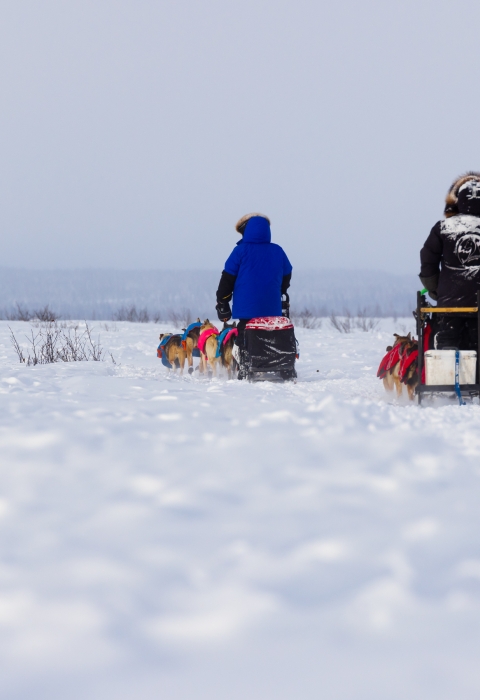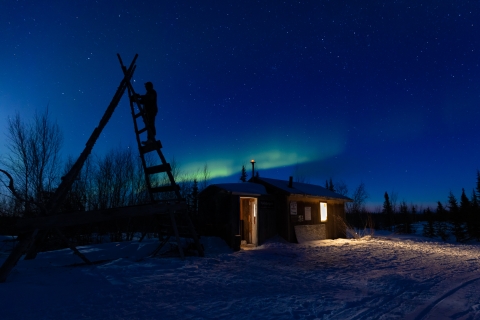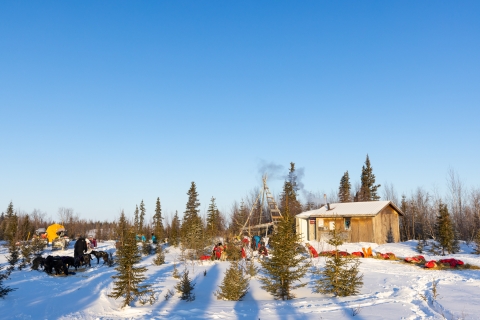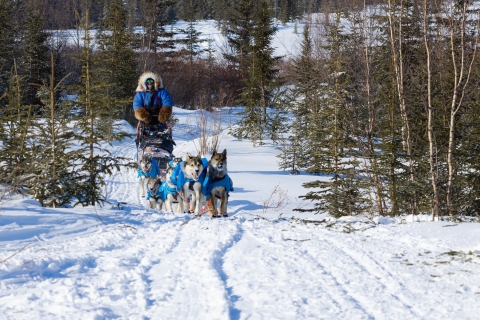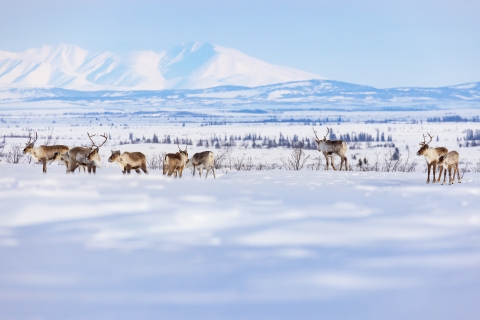It is early April above the Arctic Circle, and the temperature reads a cool -28 degrees at 3 AM. Northern lights flicker in green and purple over a small cabin and two tents. A faint shuffling noise drifts up from the frozen, quiet river and a few minutes later light from a headlamp shines through the trees.
Next, a string of dogs streaks into view and then vanish just as quickly back into the night, pulling their sled and passenger out onto the tundra – the first racer to pass by the Paniqsiġvik shelter cabin in the annual Kobuk 440 sled dog race.
More mushers follow as the night gets later and breaks into a frost-covered, sunny day. Many stop to rest at the cabin, warming up inside by the wood fire and heating up food for themselves and their dog teams. The dogs rest as well, curled up and bedded down in piles of straw. Selawik Refuge staff keep the fire going around the clock and greet the teams, one way of supporting this important regional race that runs across much of the refuge, as well as the Kobuk Valley National Park in northwestern Alaska.
Mushing has long been a way of life here, used by the Iñupiat for generations to travel across large expanses of sea ice, open tundra, and boreal forest during the winter months.
Today, people still cross this area on winter trails that connect communities using dog teams and sleds. The trails now are multi-use: shared by snowmachines, mushers, and the occasional skier or fat-tire bike. Travelers on the trails must be self-supported and ready for extreme conditions. Emergency shelter cabins, like Paniqsiġvik, dot the landscape and offer vital survival options for those who encounter trouble. This trail network is administered by the Northwest Arctic Borough in partnership with the refuge, park, and local community Search & Rescue volunteers.
The Kobuk 440 race aims to keep the tradition of mushing alive, and is a mid-distance, challenging race that takes several days to complete in a circuit from Kotzebue to Kobuk and back, approximately 440 miles. Mushers pass through communities enroute, where they find support and celebration.
“During the race, checkpoint communities come together to celebrate the Iñupiaq way of life, respect for nature, community wellness, and heritage.” – Kobuk 440 Racing Association.
Mushers also have a unique opportunity to cross the landscape of the refuge on nearly soundless sleds. A musher recounted a particularly memorable scene while she rested at Paniqsiġvik during the 2022 race: as she crossed an open tundra plain, the sun was just coming up in winter pastel colors, catching the pink hues of her dogs’ jackets. Later that day, she passed part of the Western Arctic caribou herd as they foraged on the refuge, the sun nearly ready to set over the quiet, snowy hills.
WATCH: A short video about the Kobuk 440 and Selawik National Wildlife Refuge
